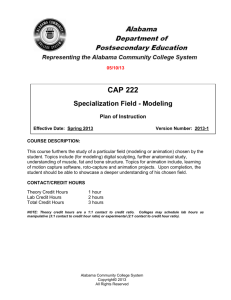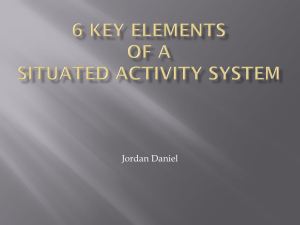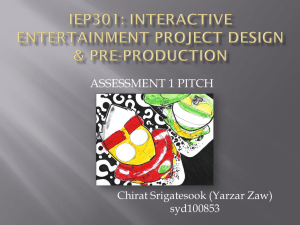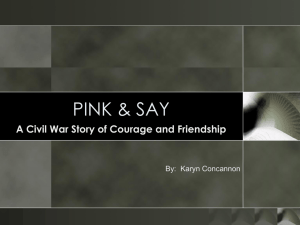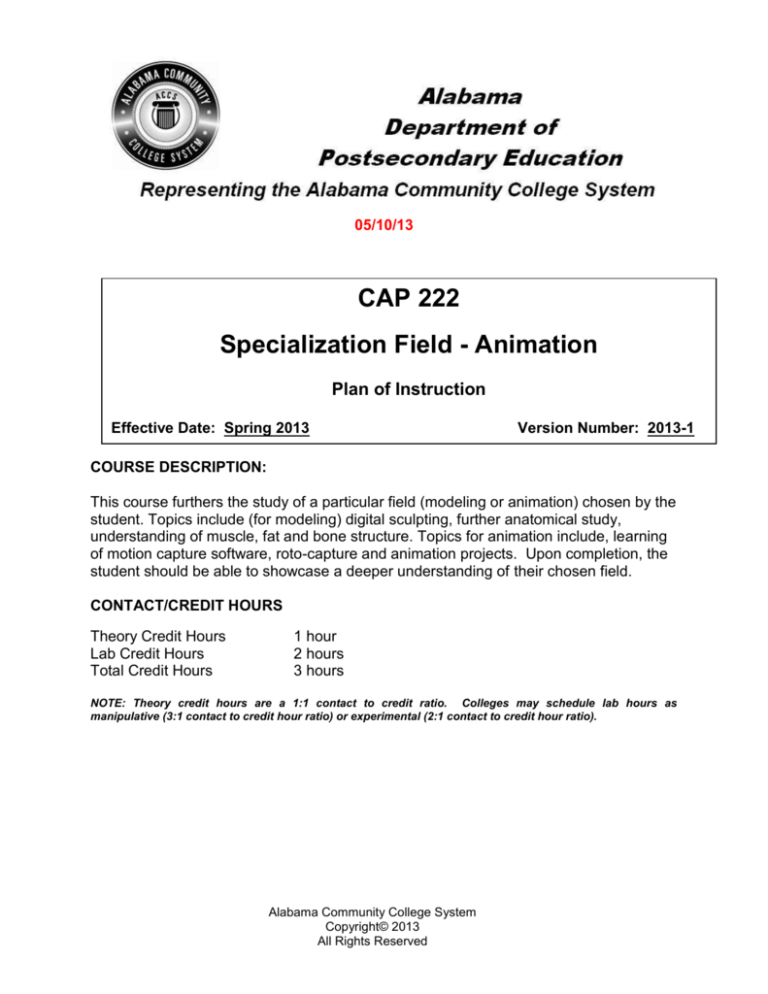
05/10/13
CAP 222
Specialization Field - Animation
Plan of Instruction
Effective Date: Spring 2013
Version Number: 2013-1
COURSE DESCRIPTION:
This course furthers the study of a particular field (modeling or animation) chosen by the
student. Topics include (for modeling) digital sculpting, further anatomical study,
understanding of muscle, fat and bone structure. Topics for animation include, learning
of motion capture software, roto-capture and animation projects. Upon completion, the
student should be able to showcase a deeper understanding of their chosen field.
CONTACT/CREDIT HOURS
Theory Credit Hours
Lab Credit Hours
Total Credit Hours
1 hour
2 hours
3 hours
NOTE: Theory credit hours are a 1:1 contact to credit ratio. Colleges may schedule lab hours as
manipulative (3:1 contact to credit hour ratio) or experimental (2:1 contact to credit hour ratio).
Alabama Community College System
Copyright© 2013
All Rights Reserved
Specialization Field - Animation
CAP 222
PREREQUISITE COURSES
None
CO-REQUISITE COURSES
As determined by college.
PROFESSIONAL COMPETENCIES
Explain the theoretical concepts in animation using motion capture.
Implement advanced practical concepts in animation using motion capture.
INSTRUCTIONAL GOALS
Cognitive – Comprehend principles and concepts related to advanced animation
or modeling.
Psychomotor – Apply principles of advanced animation or modeling.
Affective – Value the importance of understanding advanced animation or
modeling.
STUDENT OBJECTIVES
Condition Statement: Unless otherwise indicated, evaluation of student’s attainment
of objectives is based on knowledge gained from this course. Specifications may be in
the form of, but not limited to, cognitive skills diagnostic instruments, manufacturer’s
specifications, technical orders, regulations, national and state codes, certification
agencies, locally developed lab/clinical assignments, or any combination of
specifications.
ACCS Copyright© 2013
All Rights Reserved
2
Specialization Field - Animation
CAP 222
STUDENT LEARNING OUTCOMES
MODULE A – ANIMATION FIELD: MOTION CAPTURE THEORY
MODULE DESCRIPTION – This module instructs students on advanced notions relied to
motion capture and CGI animation. Topics include animation techniques, CGI animation,
motion capture industry requirements, motion capture software and workflow, and CGI
character preparation.
PROFESSIONAL COMPETENCIES
PERFORMANCE OBJECTIVES
KSA
A1.0 Explain the theoretical
A1.1 This competency is measured
3
concepts in animation using
cognitively.
motion capture.
LEARNING OBJECTIVES
A1.1.1
A1.1.2
A1.1.3
A1.1.4
A1.1.5
Explain and identify the various techniques and styles of animation.
Define various language terms for motion capture animation.
Identify when roto-capture or motion capture is necessary.
Explain how human movements can be transposed in CGI software.
Explain the necessary steps in preparing a character for Motion capture
animation.
KSA
3
4
3
4
3
MODULE A OUTLINE:
- Animation techniques
- CGI animation
Roto-capture
Motion capture
- Motion capture pipeline industry- related requirements
Games
Films
- Overview of motion capture software and motion capture software workflow
- CGI character preparation
ACCS Copyright© 2013
All Rights Reserved
3
Specialization Field - Animation
CAP 222
MODULE B – ANIMATION FIELD: MOTION CAPTURE SOFTWARE AND HARDWARE
MODULE DESCRIPTION – This module instructs students on advanced notions relied to
motion capture and CGI animation. Topics include MotionBuilder user interface,
characterization process, control rig, pose control, save keys, character settings,
constraints, and a Motion Capture session using IPiSoft.
PROFESSIONAL COMPETENCIES
PERFORMANCE OBJECTIVES
KSA
A1.0 Implement advanced practical
A1.1 Utilize the various aspects of
4
MotionBuilder to create a
concepts in animation using
motion capture.
specified animated project.
LEARNING OBJECTIVES
A1.1.1 Explain the history behind MotionBuilder.
A1.1.2 Describe the different navigation shortcuts in MotionBuilder.
A1.1.3 Describe the different ways to bring in elements in the software.
A1.1.4 Explain where to find and edit the properties for any elements.
A1.1.5 Explain and describe the characterization process.
A1.1.6 Explain why the naming convention is important.
A1.1.7 Describe how the skeletal structure should be built.
A1.1.8 Explain the difference between the A-pose and the T-Pose.
A1.1.9 Explain and describe the HumanIK rig.
A1.1.10 Describe the pose control tool.
A1.1.11 Explain and describe how to save keyframes in MotionBuilder.
A1.1.12 Explain the difference between Full body, Body Parts and Selection
modes.
A1.1.13 Explain how to use the Characters settings page for animation
retargeting.
A1.1.14 Explain the baking process from/to control rig or skeleton.
A1.1.15 Explain the motion capture process using IPiSoft.
A1.1.16 Describe the use of constraints and auxiliary pivots and effectors to
modify animation.
A1.1.17 Explain how the filters can be use to clean up the motion curves
A1.1.18 Describe how to clean up the scene before exporting in software used for
rendering.
A1.1.19 Explain what to save in the .fbx format for export.
A1.1.20 Explain how to work with multiple files.
KSA
2
3
4
4
3
4
3
4
3
3
4
4
3
4
4
3
4
4
4
4
MODULE A OUTLINE:
-
MotionBuilder history
Motion builder user Interface
Edit properties
Preferences
Navigation shortcuts
ACCS Copyright© 2013
All Rights Reserved
4
Specialization Field - Animation
-
-
-
-
CAP 222
Characterization process
Naming convention
Skeletal structure
A-Pose vs T-Pose
Control Rig
Pose Control
Save Keys
Full Body
Body Parts
Selection
Character Settings
Retargeting Animation
Baking Animation
Constraints
Motion Capture session using IPiSoft
Capture
Track Motion
Export
ACCS Copyright© 2013
All Rights Reserved
5
Specialization Field - Animation
CAP 222
LEARNING OUTCOMES TABLE OF SPECIFICATIONS
The table below identifies the percentage of learning objectives for each module.
Instructors should develop sufficient numbers of test items at the appropriate
level of evaluation.
KSA
Module A
Module B
Limited
Knowledge
and
Proficiency
1
Moderate
Knowledge
and
Proficiency
2
5%
Advanced
Knowledge
and
Proficiency
3
60%
35%
Superior
Knowledge
and
Proficiency
4
40%
60%
The KSA is NOT determined by the verb used in the learning objective, but rather in the context in which
the verb is used and the depth of knowledge and skills required.
Example: Three KSA levels using the same verb (describe):
KSA 1 – Describe three characteristics of metamorphic rocks. (simple recall)
KSA 2 – Describe the difference between metamorphic and igneous rocks. (requires cognitive
processing to determine the differences in the two rock types)
KSA 3 – Describe a model that you might use to represent the relationships that exist within the rock
cycle. (requires deep understanding of rock cycle and a determination of how best to represent it)
ACCS Copyright© 2013
All Rights Reserved
6
Specialization Field - Animation
Indicator Key Terms
1
Limited
Knowledge
and
Proficiency
2
Moderate
Knowledge
and
Proficiency
3
Advanced
Knowledge
and
Proficiency
4
Superior
Knowledge
and
Proficiency
A
Affective
Objective
ACCS Copyright© 2013
All Rights Reserved
CAP 222
Learner’s Knowledge, Skills and Abilities
Description
Recognize basic information about the subject including terms
and nomenclature.
Students must demonstrate ability to recall information such as
facts, terminology or rules related to information previously
taught.
Performs simple parts of the competency. Student requires
close supervision when performing the competency.
Distinguish relationships between general principles and facts.
Adopts prescribed methodologies and concepts.
Students must demonstrate understanding of multiple facts
and principles and their relationships, and differentiate between
elements of information. Students state ideal sequence for
performing task.
Performs most parts of the competency with instructor
assistance as appropriate.
Examines conditions, findings, or other relevant data to select an
appropriate response.
The ability to determine why and when a particular response is
appropriate and predict anticipated outcomes.
Students demonstrate their ability to seek additional information
and incorporate new findings into the conclusion and justify their
answers.
Performs all parts of the competency without instructor
assistance.
Assessing conditions, findings, data, and relevant theory to
formulate appropriate responses and develop procedures for
situation resolution. Involves higher levels of cognitive
reasoning.
Requires students to formulate connections between relevant
ideas and observations.
Students apply judgments to the value of alternatives and select
the most appropriate response.
Can instruct others how to do the competency.
Performs competency quickly and accurately.
Describes learning objectives that emphasize a feeling tone, an
emotion, or a degree of acceptance or rejection.
Objectives vary from simple attention to selected phenomena to
complex but internally consistent qualities of character and
conscience.
Expressed as interests, attitudes, appreciations, values, and
emotional sets or biases.
7


